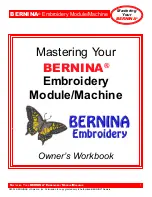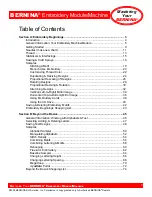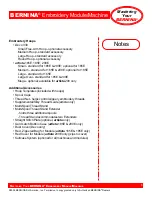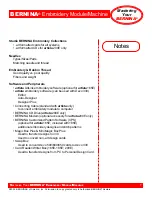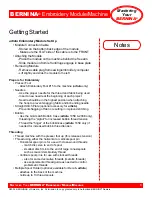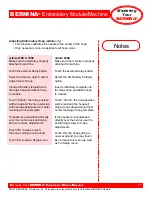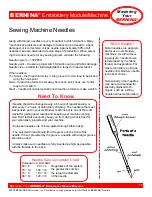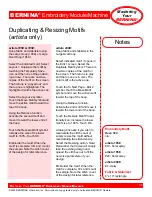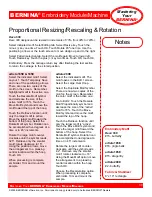
Mastering
Your
BERNINA
®
BERNINA
®
Embroidery
Module/Machine
M
ASTERING
Y
OUR
BERNINA
®
E
MBROIDERY
M
ODULE
/M
ACHINE
15
©2005 BERNINA® of America, Inc. Permission to copy granted only to Authorized BERNINA
®
Dealers
The popularity of embroidery and wearable art embellishments has
necessitated the creation and marketing of many new thread types,
such as shiny polyesters, rayons and metallics. High quality threads
made in West Germany generally have a left twist; Mettler and Isacord
threads are also left twist. To test the twist of a thread: while holding the
spool in the left hand, roll the strand of thread towards you with one
thumb. Left twist will tighten, right twist will loosen.
Fiber
– refers to the type of material used to produce the thread.
Some commonly used embroidery and embellishment threads:
•
Polyester 2 ply embroidery thread
– Isacord and Polysheen
embroidery thread – excellent for embroidery, very abrasion
resistant.
•
Acrylic embroidery thread
– excellent for embroidery,
abrasion resistant, available in variegated colors.
•
Cotton 2 ply
embroidery thread
– such as Mettler 60/2 –
excellent for French Machine Sewing, delicate machine
embroidery, piecing and darning. Has a matte finish with
a slight sheen.
•
Cotton 2 ply
embroidery thread
– such as Mettler 30/2 –
loose twist for a soft, shiny look in machine embroidery,
applique, and buttonholes. Thicker than most embroidery
threads, 30 wt cotton may require that the stitch density be
decreased slightly. Available in variegated colors.
•
Rayon
– available in 30 and 40 weight – a lustrous embroidery
thread. Weaker than cotton, it is used for decorative work only.
Available in variegated colors.
Thread Storage
Thread does wear out and should be stored with care to keep it usable
as long as possible. Extreme moisture may cause thread to swell
while very dry conditions can leave it dry and brittle as it ages. Store
thread in a covered place (thread box with a lid, cabinet with doors,
or drawers that close) if possible to keep it dust-free.
Be wary of old spools of thread recovered from Grandma’s sewing box.
The fibers may be so weak and brittle that even if it sews without
breaking, it may be so unstable that the garment or project will not hold
together and the life of the project may be considerably shortened.
Embroidery Thread
Notes

